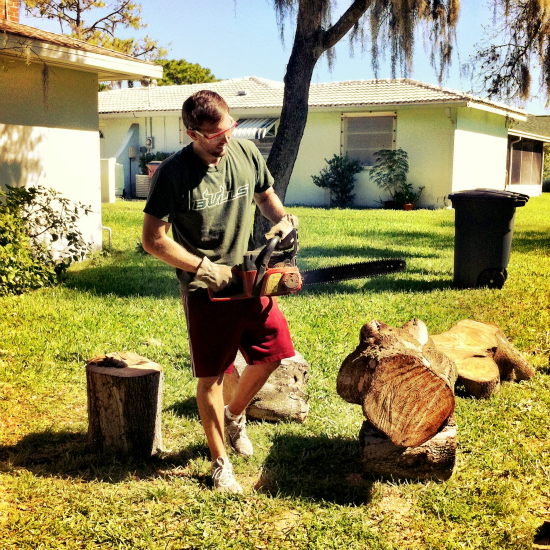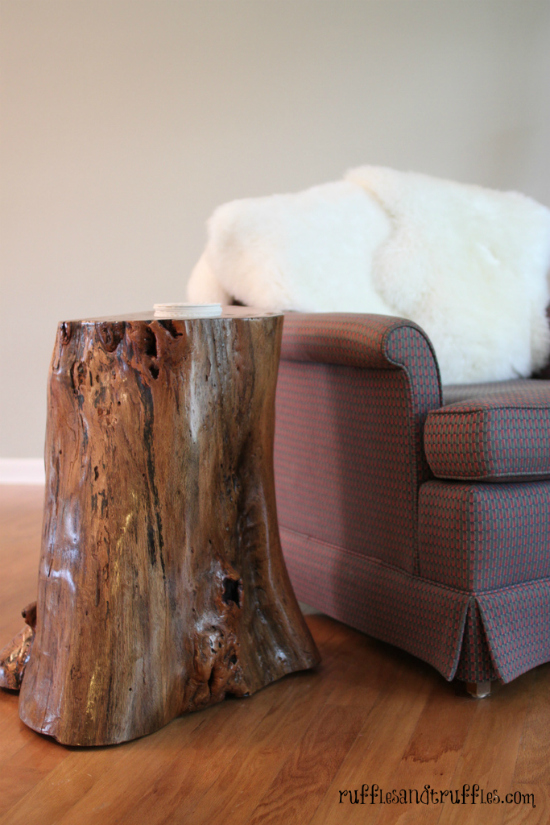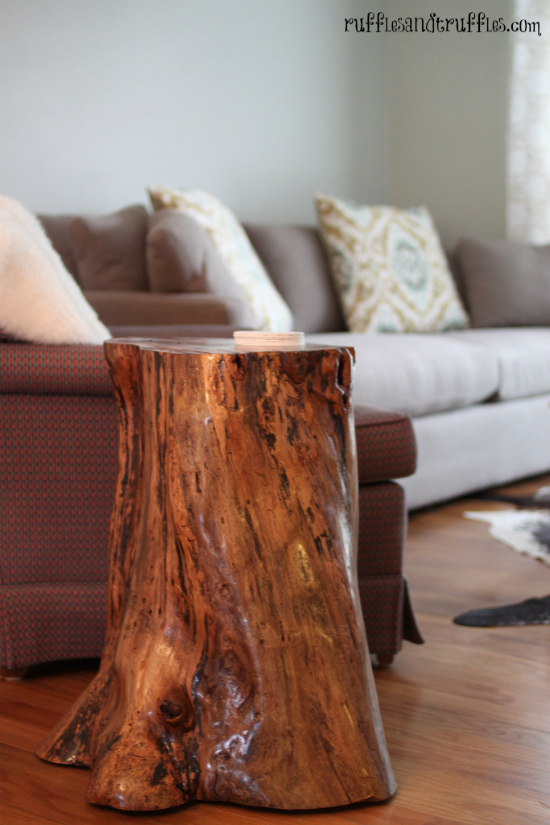It started with a storm.
Late last summer, a storm ran through our part of town. It wasn’t unusual by any means, but my in-laws’ backyard was unlucky enough to suffer a blow by lightning. A tree outside was struck: thankfully it didn’t fall down and damage anything, but the state it was left in necessitated its removal from the yard. Little did I know it was about to become this amazing tree stump table DIY project…
That’s when the lightbulb went off in my head. We were having Sunday lunch at my in-laws’ house and they were telling me about the tree/pointing it out in the yard. The wheels began turning in my brain. I asked if I could go outside to look at it, and after assessing the width and appearance of the tree, I turned to my father-in-law and asked him if I could have it. I’m pretty sure he thought I was crazy at that point, but I had a plan for that tree. A plan that took months to complete, but was absolutely worth it in the end. You see – I wanted that tree to become an end table for our new house. And I knew I could convince my dear husband to help me with it. So, shortly after I secured the tree as mine, Justin spent a Saturday afternoon with a chainsaw, cutting it down to size.
There were a few pieces to choose from, but one in particular caught my attention because of the shape – I knew it would sit in a pretty way on the floor…looking like it is growing into the ground.
Funny enough: the process to create this tree stump table was actually very simple. It just takes a long time to complete: you must have patience.
To start: we cut down the stump (of course). We measured the height from the floor to the arm rest of our couch to know how tall the table should be, and added an extra 2 inches to that measurement (to leave room for sanding/leveling). Justin then used a belt sander to level out the log on top and bottom.
When the stump was leveled, it was time to wait. The stump needed to be drained of moisture before any next steps could be taken. So, we set the log under a covered area out in my in-laws’ backyard and let it sit…for about 3 months. At that point, the stump was pretty much dried out (and had lost a few pounds).
Next step: stripping the bark! Justin used a small chisel to strip the bark off the sides of the tree stump. The process wasn’t very difficult, as the 3 month drying process had loosened it up at that point. When the bark was fully removed, we kept the stump outside on our covered patio and began the sanding process (Justin completed this over the course of a few weeks when he had free time).
For the sanding: Justin began with 60 grit sandpaper (over the entire stump). When he’d smoothed it as much as he could with the 60 grit, he progressed to 150 grit paper and repeated. Then, for the finishing touch, he worked with 220 grit sandpaper. After the 220 grit was used on the stump, it was completely smooth to the touch, and there was no fear of splinters for anyone touching it.
When the stump was finally complete with the sanding process, we moved the it inside our garage for about 2 weeks to acclimate to climate control. If you live in a colder area (we are in Florida and it was warm at the time), I would suggest moving it inside your house so the stump can adjust to the typical room temperature.
Next, it was time for the polyurethane coating. We were thinking about staining the wood before sealing it with polyurethane, but we determined that we wanted a natural look for the stump and didn’t want to make it darker at all. If you DID want to stain your tree stump, this is when you would do it. However, we decided to just seal it. Justin applied the polyurethane coating with a foam brush – in a well ventilated area (we opened the garage door)! After the first coat had dried, he used the 220 grit sandpaper over the entire stump. Then, a second coat of polyurethane was applied.
The polyurethane needed 2 coats on the sides and bottom of the stump, but ended up taking about 5 coats on the top (it kept soaking into the stump). When complete, the entire tree stump was shiny and beautiful! We allowed it to dry completely, then flipped the stump over to hammer in some felt feet on the bottom to protect our wood floors from the heavy table.
And then: we placed this beautiful stump table creation in our living room and started enjoying it. I really do love how it turned out, and it has definitely become a conversation piece when people visit our home. I love that we can proudly say we made it. Ok…I conceptualized it, and Justin pretty much made it…but you get what I mean.
All in all, it was a very affordable project (the cost of sandpaper and polyurethane…maybe around $20), but just took a good chunk of man hours to complete. If you don’t happen to have a tree that was struck by lightning in your backyard like we did, you could also look into fire wood lots that would have large logs to purchase: I’m betting it still wouldn’t cost you too much.
Do you love creating DIY projects for your home? What is your proudest DIY accomplishment?






























That looks amazing! Your hard work paid off. I totally want to go find an abandoned tree stump now.
This turned out so amazingly well! I’ve had this on my DIY list for a while now and you’ve definitely motivated me.
Brilliant!!!
This is great, it look like a sculpture.
I have three stumps waiting for me to turn them into tables.
Same thing here with my husband, I think, he makes. Aren’t we lucky?
Thanks so much Tina! I am jealous that you have a couple of stumps on hand for table making!
This is amazing and adds such a polished but earthy touch to your room!
That was such a brilliant idea and it turned out so beautifully! Looks perfect in your living room! Thanks for sharing this project!
Thanks Beckie! We are really proud of it, and I love that my husband gets to brag a bit when people ask about it.
Such a great idea! I’ve been wanting to do this for a long time, but there never seems to be a tree stump available in anybody’s garden 😛
We really got lucky with the tree that needed to be taken out of the in-laws’ yard. I don’t know if I would have been able to complete this project otherwise!
Wow! You just gave me an idea! I would love to do the same, i just need to find some tree stumps now! Very nice! Great job!
I saw this and knew that I wanted to make it. So I went up the street and asked my neighbor for her tree stumps and am beginning the process! Thanks for the inspiration!
Awesome! I hope it turns out well for you! 🙂
I’m wondering if you *have* to dry it out and why and how to know if it’s dried enough if you found it in the woods with no bark? (And part of it is kind of moist)? I just found one in the woods but I don’t know if it’s dry enough.
Melody – drying out the stump is definitely a necessary process, I would say. If you seal the stump without letting the moisture out, you’d be sealing it inside, and I believe that would cause it to rot. Leaving the stump out in a dry place (like your garage) for a few months is a good idea. But I’m just speaking from the standpoint of what we personally did with ours!
Thanks!
Some parts of my stump are rotten. I’m worried about that but I can’t find a better stump and this one is already dried out. Just rotten in some places….. D: I’m hoping to carve out bits of that and let it dry out more… then sand it down and everything, and let it dry out more. Then finally I can coat with some kind of sealer much later. Sound doable?
Hi, your stump came out amazing! I have one I am trying to decide whether to stain or not. Can you pleas tell me what type of polyurethane you used and was it gloss or satin? I do see some shinyness. Love it.
Your table turned out beautifully and is exactly the finish that I’ve been wanting! I notice in your pictures that the polyurethane really darkened up the wood. Is that just the lighting or can I expect that to happen? My mesquite stump is a bit yellow with the bark off. I want to keep the natural markings to it, but I would also love that rich beautiful color! Trying to decide if I should stain it.
Laura – the polyurethane definitely darkened the stump up quite a bit. We had considered staining it at first, but my husband suggested we paint a small portion with the polyurethane first to see what that color would look like. It turned out the medium brown it turned was just what I was looking for, so we got very lucky! If I hadn’t liked the color, we would have just sanded down that part a bit and stained it. Glad I didn’t need the extra step though!
This is what I’ve been looking for! Thank you.
what about insects? I would worry about bringing a large chunk of tree inside the house if there was even the possibility of insects (like termites) living inside it.
Heather – we spent months drying out the log outside of our house, and then in our garage. As my husband spent hours sanding down the sides, he never noticed any bugs. We did not bring the stump inside until it was fully sealed with a few coats of polyurethane as well. We’ve had the stump table in our home for a year now and it’s definitely fine! Although if you did happen to see bugs in a log you were working on, I think you could spray an insect killer and wrap it in plastic to keep it airtight for a few days to kill any insects that might be lurking!
Very nice indeed! I always wondered why so many tree stumps look so inviting. To think they are often merely discarded or left aside. Amazing.
Katie, would you be up for selling this stump table piece? Or did you make a bunch more that you’d be up for selling one? I know it’s pretty much exactly the opposite of what this posting is about, but wanted to at least ask. I love it. Thanks!
Hey David –
At the moment, I don’t think I want to sell this piece because I love it so much. We do have another stump sitting in our garage that I’m pondering what to do with though! It’s still unfinished at this point.
I thought you were supposed to soak it in some solution to kill any insects. Hmmm…. I may try someday but think I’d finish it in a satin poly. Would look more natural and still be protected.
Robin – I’m sure there is a product out there to do that if you’re worried! The drying process we went through with the stump took quite a while, and by the time we were done we were certain there weren’t any insects inside. We’ve had the table in our house for more than a year and a half at this point and there have been no problems whatsoever! Still looking great 🙂
I have done a lot of wood projects, instead of the 5 coats of polyurethane, try using Famowood Glaze Coat. One coat should do it, and its beautiful for indoor projects. I use it for tons of crafts, way more than just wood. But it is so much thicker that one coat does it for almost everything.
Looks so good! Did you use oil base or water base polyurethane?
[…] 10. Tree Log Coffee Table […]